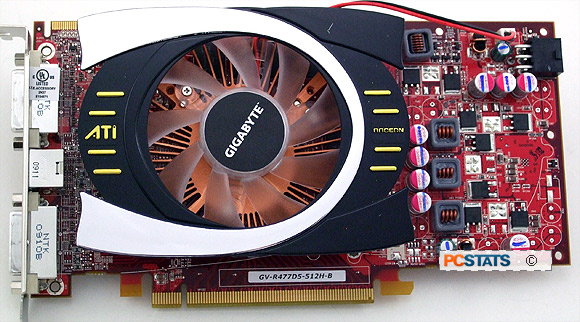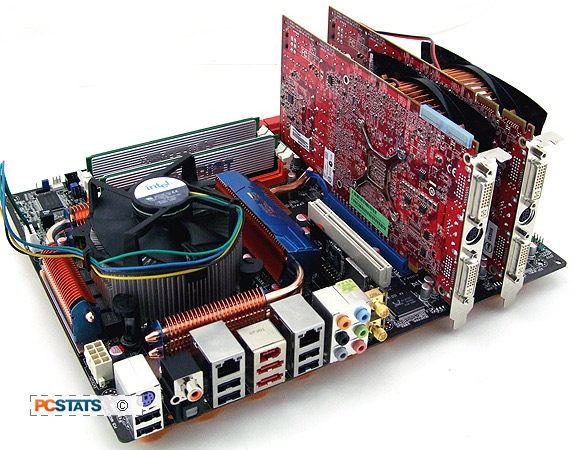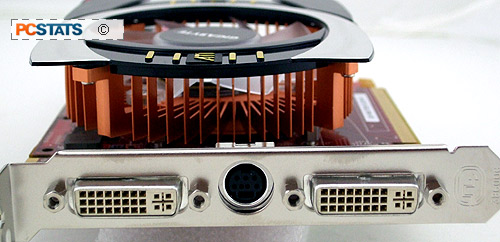If you missed the launch of ATI's Radeon HD 4770 GPU you're in for a
special treat today. PCSTATS is testing out Gigabyte's
GV-R477D5-512H-B Radeon HD 4770 videocard alone, and in
Crossfire mode so you'll know exactly what two of these mainstream cards
can do for you! We already know one Radeon HD
4770 graphics card offers great performance for under a hundred bucks,
the real question is what level of gaming performance will two 4770's
teamed up under Crossfire deliver? Mainstream videocards often scale
faster and farther than pricey flagship videocards, so it'll be interesting
to see where two Radeon HD 4770's stand against videocards several times
their price.
First the basics. ATI's Radeon HD 4770 (code name RV740) is derived
from the venerable Radeon RV770 GPU. The Gigabyte GV-R477D5-512H-B videocard has
its GPU clocked at 750MHz and is equipped with 512MB GDDR5
memory running at 800MHz, giving it a bandwidth of 51.2 GB/s. The memory
bus is 128-bit wide, which should make for an interesting comparison between it
and the mainstream Radeon HD 4850. PCSTATS will breakdown all the numbers
in a moment, including benchmarks with the GV-R477D5 card running in Crossfire,
but first let's introduce you to Gigabyte's GV-R477D5-512H-B PCI
Express 2.0 x16 graphics card.
The Gigabyte GV-R477D5-512H-B videocard is based on the
reference design and uses a simple two-slot wide aluminum heatsink in place of
the standard ATI
thermal solution. It's a little ugly as videocards
go, but it's quiet and that's what matters most. The GV-R477D5-512H-B
is PCI Express 2.0 x16 compliant, comes with 512MB of GDDR5 memory and the usual
list of supported features; ATI CrossfireX, HDCP, DX10.1, SM4.1, and Unified
Video Decoder 2 for HD content decoding. The Gigabyte GV-R477D5-512H-B
videocard retails for about $109USD / $130CDN / £60GBP at stores
like Newegg or Canada Computers.
 |
|
Gigabyte
GV-R477D5-512H GDDR5 512MB Videocard |
|
|


|
| Includes: |
|
User's Manual, Driver CD, Utilities CD,
DVI-to-HDMI Adapter, DVI-to-VGA adapter,
Component output splitter, 6-pin to molex power cable. |
 | | |
When paired up with an appropriate motherboard, ATI Crossfire X allows multiple GPUs
to split up rendering loads between them for better performance in games. The
videocards have to be in the same family in order to work together. So in the
case of the Radeon HD 4770, it's the first of its kind, and only compatible with
other Radeon HD 4770 videocards.
Two Radeon HD 4770 videocards will cost a little over $200 USD, a price that
floats somewhere between the Radeon HD 4870/Geforce GTX 260 and Radeon HD
4890/Geforce GTX 275. Given the proven performance of a single Radeon HD 4770 in
comparison to videocards that cost twice as much, it's entirely possible that a
pair of Radeon HD 4770s could outperform most of the $200-$300 on the market
right now.

At the back of the Gigabyte GV-R477D5-512H-B videocard are two dual-link DVI
outputs capable of a maximum resolution of 2560x1920 each. The S-video
connection supports component video output. The card itself requires one 6-pin
power connection and is Crossfire X compatible so multiple videocards can be
teamed. The Gigabyte GV-R477D5-512H-B videocard is equipped with a large and
fairly quiet aluminum heatsink with inset fan. The additional height of the
heatsink means the Gigabyte GV-R477D5-512H-B videocard will occupy two expansion
slots instead of just one. Under testing the fan made an audible hum at full
speed, but was practically silent when set to run automatically.

The stock fan design doesn't exhaust hot air out through the rear of
the computer case, so any hot air is dumped back inside the system chassis.
While this will raise ambient temperatures inside the case by a few degrees,
adding in a system fan can easily remedy the problem.

Given its competitive pricing, it's not surprising that the
Gigabyte GV-R477D5-512H-B comes with relatively few extras. Inside the box you'll find a pair of
driver CDs, a short installation guide, a molex to PCI Express power adapter, a
Component adapter, a DVI to VGA adapter, and most importantly a DVI to HDMI
adapter. Since this is an AMD Radeon HD videocard, the HDMI adapter is HDCP
complaint and will also carry audio signals without the use of any additional
cabling.

